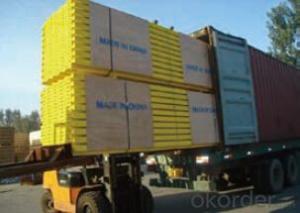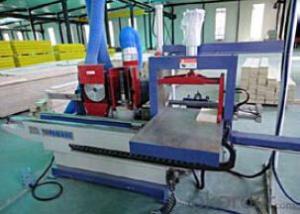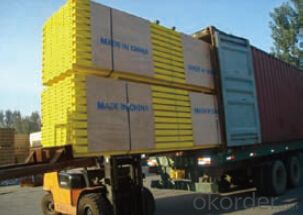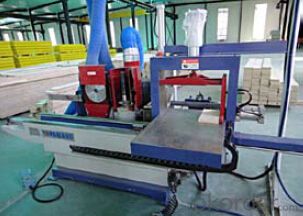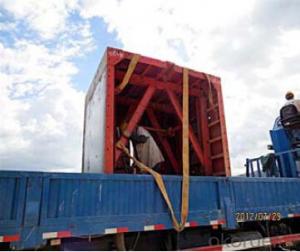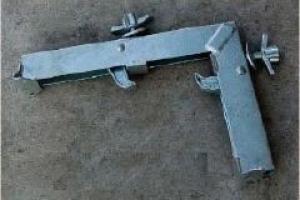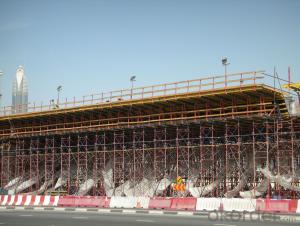Timber Beam H20 for formwork and scaffolding systems
- Loading Port:
- Tianjin
- Payment Terms:
- TT OR LC
- Min Order Qty:
- 50 m²
- Supply Capability:
- 1000 m²/month
OKorder Service Pledge
OKorder Financial Service
You Might Also Like
Characteristics:
◆ Standardized production lines.
Supply capability: 3000m/day, Lmax = 6600mm.
◆ Finger jointing of the flange and web, the strength of timber beam is highly improved.
Max. shearing force failure load:40KN
◆ Well treated to prevent from water penetration or erosion, so the service life maximally extended.
Normally, CNBM timber beam H20 can be used for 4 to 5 years, the exact using time would depend on maintenance & storage.
◆ Robust caps at the end of the girders protect against damages.
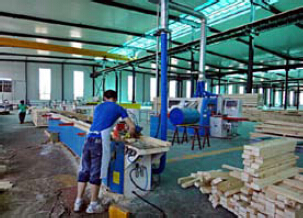
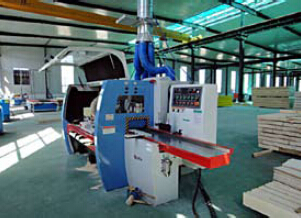
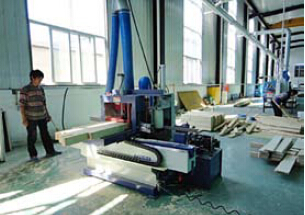
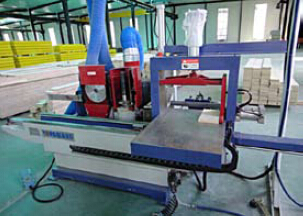
- Q: How does steel formwork handle formwork stripping and cleaning?
- Steel formwork is known for its durability and strength, making it highly suitable for handling formwork stripping and cleaning processes. When it comes to formwork stripping, steel formwork can easily be disassembled and removed from the concrete structure without causing damage. This is due to the inherent rigidity and stability of steel, which allows for efficient and safe stripping. Moreover, steel formwork is resistant to moisture, chemicals, and other environmental factors, making it easier to clean and maintain. After the formwork is stripped, any concrete residue or debris can be easily removed from the steel surface using appropriate cleaning techniques. This may involve the use of high-pressure water jets, scrubbing, or other cleaning agents, depending on the specific requirements. Steel formwork also offers the advantage of reusability, as it can withstand multiple uses without significant deterioration. Once the formwork is cleaned, it can be inspected for any damages or wear and tear. Any necessary repairs or replacements can be made to ensure the formwork's integrity for future use. In summary, steel formwork handles formwork stripping and cleaning efficiently due to its durability, strength, and resistance to environmental factors. Its easy disassembly, cleaning capabilities, and reusability make it a preferred choice for construction projects where formwork needs to be stripped and maintained regularly.
- Q: What are the different safety guidelines for dismantling steel formwork?
- When dismantling steel formwork, there are several important safety guidelines that should be followed to ensure the protection of workers and prevent accidents. These guidelines include: 1. Personal Protective Equipment (PPE): All workers involved in the dismantling process should wear appropriate PPE, including safety goggles or glasses, gloves, hard hats, and steel-toed boots. This will protect them from potential hazards such as falling debris or sharp edges. 2. Training and Competency: Only trained and competent individuals should be assigned to dismantle steel formwork. They should have a good understanding of the dismantling process and be aware of the potential risks involved. 3. Safe Work Area: Before starting the dismantling process, the work area should be properly prepared. This involves clearing any obstructions or hazards, ensuring a stable and level ground, and marking off the area to prevent unauthorized access. 4. Tools and Equipment: Workers should use appropriate tools and equipment for dismantling steel formwork. This may include wrenches, hammers, cutting tools, and lifting equipment. Tools should be inspected regularly for any damage or defects and replaced if necessary. 5. Structural Stability: Before dismantling any part of the formwork, workers should ensure that the structure is stable and secure. This may involve using temporary supports or bracing to prevent any collapse or movement during the dismantling process. 6. Sequential Dismantling: Steel formwork should be dismantled in a sequential manner, starting from the top and working downwards. This helps maintain the stability of the structure and minimizes the risk of uncontrolled collapses. 7. Controlled Lowering: When dismantling larger steel formwork components, such as panels or beams, they should be lowered in a controlled manner using appropriate lifting equipment. This prevents sudden movements or drops that could cause injuries or damage. 8. Communication and Coordination: Clear communication and coordination between workers involved in the dismantling process is crucial to ensure everyone's safety. This includes using hand signals, verbal communication, and following a pre-determined plan or procedure. 9. Regular Inspection: Regular inspection of the steel formwork during the dismantling process is important to identify any signs of damage, corrosion, or structural defects. Any issues should be reported immediately and appropriate actions taken to address them. 10. Emergency Procedures: Workers should be familiar with emergency procedures in case of accidents or unexpected events. This includes knowing the location of emergency exits, fire extinguishers, and first aid kits, as well as understanding how to respond to incidents such as a collapse or injury. By following these safety guidelines, the risk of accidents and injuries can be significantly reduced during the dismantling of steel formwork. It is important to prioritize the safety of workers and ensure that proper precautions are taken at all times.
- Q: Can steel formwork be used in areas with high moisture content?
- Yes, steel formwork can be used in areas with high moisture content. Steel is highly resistant to moisture, making it suitable for use in humid or wet environments. It is less likely to warp, rot, or deteriorate compared to other materials like wood. However, proper surface protection such as anti-corrosion coatings or galvanization may be required to ensure the longevity and performance of the steel formwork in high moisture conditions.
- Q: Can steel formwork be used for both horizontal and vertical concrete placement?
- Both horizontal and vertical concrete placement can utilize steel formwork. Steel formwork is a versatile and long-lasting solution for creating molds or frames that maintain wet concrete in the desired shape until it sets and hardens. This kind of formwork is frequently employed in construction projects for various purposes, including horizontal and vertical concrete placement. Steel forms possess enough strength to withstand the weight and pressure of the concrete, which renders them suitable for vertical applications like walls, columns, and beams. Moreover, steel formwork can be easily adjusted or modified to accommodate different shapes and sizes, making it perfect for horizontal placements such as slabs, floors, and pavement. In general, steel formwork offers flexibility, strength, and stability, making it suitable for a wide range of concrete placement requirements.
- Q: Can steel formwork be used for energy-efficient concrete buildings?
- Yes, steel formwork can be used for energy-efficient concrete buildings. Steel formwork provides excellent strength and durability, allowing for the construction of complex concrete structures with high thermal performance. Additionally, steel formwork can be easily reused multiple times, reducing waste and promoting sustainability in the construction industry.
- Q: What are the different types of steel formwork accessories available?
- Some common types of steel formwork accessories include form ties, formwork clamps, anchor bolts, formwork brackets, formwork connectors, and formwork spacers. These accessories are essential for ensuring the stability and proper alignment of the formwork system during concrete construction projects.
- Q: How does steel formwork contribute to the overall sustainability credentials of the project?
- There are several ways in which steel formwork contributes to the overall sustainability of a project. Firstly, steel is a highly durable material that can be reused multiple times, reducing the need for constant replacement and minimizing waste generation. This not only saves costs but also reduces the environmental impact associated with the production and disposal of formwork materials. Moreover, steel formwork is renowned for its strength and stability, enabling efficient and accurate construction processes. This results in reduced material waste and optimized resource utilization. Additionally, the use of steel formwork leads to faster construction cycles, resulting in shorter project durations and decreased energy consumption. Furthermore, steel is a recyclable material, meaning that it can be easily recycled and transformed into new products at the end of its life cycle. This reduces the demand for virgin materials and the associated carbon emissions, contributing to a more resource-efficient construction industry. Additionally, steel formwork offers design flexibility, allowing for the creation of complex shapes and structures. This versatility promotes innovative architectural solutions that can potentially optimize energy efficiency and enhance the overall sustainability of the building design. Lastly, steel formwork enhances the safety and health standards on construction sites. Its robustness and stability ensure a secure working environment, reducing the risk of accidents and injuries. By prioritizing worker well-being, steel formwork fosters a responsible and ethical approach to construction practices, supporting the sustainable development of the project. In summary, steel formwork contributes to the overall sustainability of a project by reducing waste generation, optimizing resource utilization, enabling faster construction, promoting circular material management, enhancing design flexibility, and prioritizing worker safety.
- Q: Can steel formwork be used in areas with high chemical exposure?
- While steel formwork can be utilized in areas characterized by high levels of chemical exposure, it may not necessarily be the most optimal selection. Although steel is generally recognized as a resilient and robust substance, it is prone to corrosion upon encountering specific chemicals. In situations where the chemicals prevalent within the vicinity are known to induce corrosion in steel, it is advisable to contemplate alternative formwork materials like plastic or aluminum, which possess a higher resistance to chemical exposure. Moreover, it is feasible to enhance the steel formwork's chemical resistance by applying protective coatings or treatments. Nonetheless, it is crucial to thoroughly assess the particular chemicals and their concentration within the area in order to ascertain the most suitable formwork material for the project.
- Q: What are the different types of steel formwork clamps and connectors?
- Construction projects utilize a variety of steel formwork clamps and connectors, each serving a crucial role in maintaining the stability of the formwork during concrete casting. Here are some commonly used types: 1. Wedge clamps: These clamps effectively secure formwork panels by utilizing a wedge-shaped piece. They are popular for temporary formwork due to their easy installation and removal. 2. Rapid clamps: Designed for quick installation and removal, these clamps have a spring-loaded mechanism that allows for easy adjustment and tightening. They are commonly employed in time-sensitive situations like high-rise construction. 3. Scaffold clamps: Used to connect formwork to scaffolding systems, these clamps ensure a secure and stable connection between the two components during construction. 4. Column clamps: Specifically designed for connecting formwork panels around columns or pillars, these clamps come in various sizes to accommodate different column diameters. They provide a strong and stable connection. 5. Corner clamps: These clamps are employed to connect formwork panels at corners, ensuring a tight fit and preventing any gaps. They offer adjustability, allowing for flexibility in formwork design and easy alignment of panels. 6. Beam clamps: These clamps secure formwork panels to horizontal beams or joists, distributing the load evenly and ensuring overall stability of the formwork system. 7. Pin and wedge connectors: These connectors consist of steel pins and wedges that join formwork panels together. The pins are inserted into pre-drilled holes, and the wedges are hammered in to create a tight connection. They provide a reliable and durable solution. 8. Tie rods and wing nuts: These components work in conjunction with clamps to provide additional support and reinforcement to the formwork system. Tie rods, threaded steel rods, are inserted through the formwork panels and secured with wing nuts, creating a strong and rigid connection. It is important to consider that the specific clamps and connectors used may vary depending on project requirements and the formwork system in use. Consulting a structural engineer or formwork supplier is advisable to determine the most suitable clamps and connectors for a particular construction project.
- Q: Types of building templates? What is the clear water template
- 1 plastic template: at present, there are many companies to develop a variety of plastic template, such as hard template, reinforced plastic wood plastic composite template, GMT plastic, plastic and plastic floor template template template system, reduce wood cutting, replacing the traditional technology with new technology, I believe the future will be used widely used in building materials industry.
Send your message to us
Timber Beam H20 for formwork and scaffolding systems
- Loading Port:
- Tianjin
- Payment Terms:
- TT OR LC
- Min Order Qty:
- 50 m²
- Supply Capability:
- 1000 m²/month
OKorder Service Pledge
OKorder Financial Service
Similar products
Hot products
Hot Searches
Related keywords
